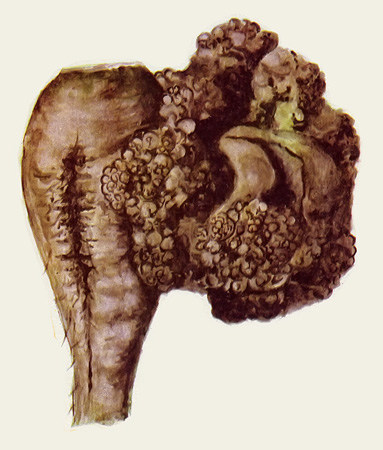Diseases
Xanthomonas beticola (Smith, Brown, Townsend) Savelescu - Tuberculosis of Beet.
Systematic position.
Kingdom Procaryotae, section Gram-negative aerobic rods and cocci, family Pseudomonodaceae, genus Xanthomonas.Synonyms.
Bacterium beticolum Smith, Brown, Townsend, B. beticola (Smith, Brown, Townsend) Potebnia, Pseudomonas beticola (Smith, Brown, Townsend) Holland, Phytomonas beticola (Smith, Brown, Townsend) Bergey et al.Biological group.
Hemibiotroph.Morphology and biology.
The first symptoms of the Tuberculosis of Beet appear at the end of summer, even into autumn, and after allocation of roots to storage. The disease is shown as irregular-shaped outgrowths on the top part of roots or stems of plants. These outgrowths have a rough, spongy surface. The internal tissue of outgrowths is friable, mucous. It subjects to fast rotting and disintegration. Cutting of outgrowths reveals cavities filled with bacterial slime. The secondary microflora is present on outgrowths, causing fast decomposition of outgrowths and then the entire root. Landing of infected seed-roots causes the disease symptoms on stems or tops of stems, resulting in bending and detaining of growth. Cells X. beticola are straight bacilli with rounded ends, usually 0.6-0.8 x 1.5-2.0 mkm, moving by means of 1-4 flagella. Forming capsules. Non-sporing. Gram-negative. On firm nutrient mediums, colonies grow quickly and are yellow and smooth (with even edges) or folded (with concentric circles). Grow well on Fermi's and Ushinskii's mediums, but not on Kon's medium. Diluting gelatin. Curtailing milk slowly with formation of yellow film. Litmus milk appears blue in the beginning, then becomes colorless. Decomposing starch very poorly or not decomposing starch. Restoring nitrates. Forming H2S, NH3 and indol. Excreting acids at fermentation of dextrose, levulose, galactose, lactose, saccharose, glycerin and mannitol. The maximal temperature for growth is 39°C, minimal 1.5°C, thermal 51-52°C. The pathogen is resistant to drying, but not resistant to freezing. During the vegetation period, the pathogen is capable of spreading through the damages made by insects as well as through mechanical damage of plants.Distribution.
The Tuberculosis of Beet occurs in the USA. The disease is marked in the territories of the Russian Federation (the Yaroslavl Region, Krasnodar and Altay Territories), and also in Moldova, Georgia, Armenia, Kazakhstan, and Ukraine.Ecology.
The high temperature and relative humidity of air (90% and higher) favor the development of bacterial infection.Economic significance.
The pathogen attacks table, sugar, and fodder beets. During favorable conditions, the percentage of diseased roots reaches 17-21% in some years (Armenia). Infected roots decay quickly under the influence of secondary infection; therefore, they are often a source of infection in vegetable storehouses. The sugar content is considerably reduced in diseased roots. Control measures include optimal agriculture, including maintenance of crop rotation, cultivation of relatively resistant varieties, careful removal of plant residues, separating seeds from shrunken grains, treatment of seeds with pesticide prior to planting, and treatment of plants with pesticides during the vegetation period.Reference citations:
Bilai, V.I., Gvozdyak, R.I., Kraev, V.G., Ellanskaya, I.A., Zirka, T.I. & Muras, V.A. 1988. Microorganisms are the pathogens of diseases of plants. In: Bilai, V.I., ed. Kiev: Naukova dumka, 552 p. (in Russian)Galach'yan, R. M. 1961. The ways of infection by the Tuberculosis of Beet. In: Panosyan, A.K., ed. Voprosy mikrobiologii.Vol. I (XI). Yerevan: Izdatel.stvo AN Armenskoi SSR, p. 41-52 (in Russian).
Galach'yan R.M. 1958. The Tuberculosis of Beet in Armenia. In: Panosyan, A.K., ed. Voprosy mikrobiologii.Vol. I I I (IX). Yerevan: Izdatel.stvo AN Armenskoi SSR, p. 139-155 (in Russian).
Gorlenko, M.V. 1947. A survey of geographical distribution of bacterial plant diseases in the USSR. Byulleten. obshchestva ispytatelei prirody, otdelenie biologii 32 (2): 61-70 (in Russian).
Gorlenko, M.V. 1966. Bacterial diseases of plants. In: Sokolov, N.A., ed. Moscow: Vysshya shkola, 291 p. (in Russian)
Shpaar, D, Cleinkhempel, G, Myuller, G. & Naumann, K. 1980. Bacterioses of cultural plants. Handbook Moscow: Kolos, 143 p. (in Russian)
Yagudin, V.D., Shklyar, S.N. 1979. Bacterial diseases of plants In: Izrail.skii, V.P., ed. Moscow: Kolos, 288 p. (in Russian)
Yashnova, N.V. 1960. The Tuberculosis of Beet. In: Izrail.skii, V.P., ed. Bacterial diseases of plants. Moscow: Gosudarstvennoe izdatelstvo selskokhozuaistvennoi literatuty, p.262-266 (in Russian).


